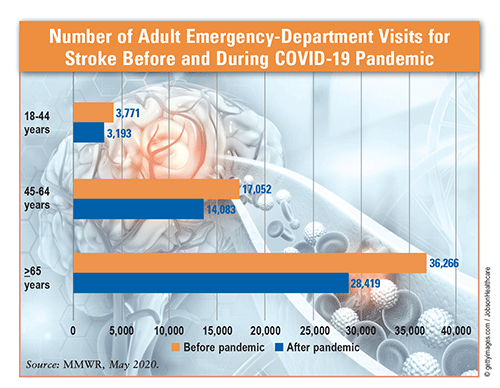US Pharm. 2023;48(2):15.
A stroke is a life-threatening condition in which the blood supply to the brain is restricted or blocked by a clot. Ischemic strokes, which account for >85% of all strokes, occur when the blood supply to the brain is blocked. Hemorrhagic strokes are less common, and this type results from a weakened blood vessel bursting and causing bleeding in the brain. Common signs and symptoms of stroke include sudden weakness, numbness, paralysis, difficulty speaking and/or walking, visual disturbance, dizziness, and/or severe headache.

Incidence and Risk Factors: The American Heart Association notes that annually >795,000 people in the United States have a stroke. An estimated 610,000 of these are first or new strokes, with 185,000 people experiencing subsequent strokes within 5 years. In 2020, one in six U.S. deaths from cardiovascular disease (CVD) was due to a stroke, making stroke the 5th leading cause of death among all Americans and the 3rd leading cause among U.S. women. Stroke is the leading cause of serious long-term disability (e.g., reduced mobility in >50% of stroke survivors aged 65 years and older). High blood pressure (HBP), high cholesterol, diabetes, obesity, and cigarette smoking are the most common causes of stroke, and one in three U.S. adults has at least one of these risk factors. Previous stroke or transient ischemic attack, heart disease, male sex, living in the southeastern U.S., black race, and Hispanic ethnicity are other risk factors.
Age-Related Trends: Stroke risk increases with age, doubling each decade after age the of 55 years. About 75% of strokes occur in people aged 65 years and older. However, an analysis of data from the Global Burden of Disease Study found a decreased stroke incidence among U.S. adults aged 50 years and older from 1990 to 2019. In contrast, the incidence increased in individuals aged 15 to 49 years, particularly in the southern and midwestern U.S.; one reason for this may be the increased HBP and diabetes rates among younger and middle-aged adults. Decreases in emergency-department visits for CVD were seen in all adult age groups from 2019 (before the pandemic) to 2020 (during the pandemic). National Syndrome Surveillance Program data show that emergency medical visits for stroke declined an average of 18% among all U.S. adults aged 18 years and older during this period.
Disease Projections: The overall prevalence of stroke in the general population has increased by ~60%, whereas incidence, death, and disability-adjusted life-years increased by ~20% from 1990 to 2019. U.S. Census Bureau and U.S. National Health and Nutrition Examination Survey data predict a continued increase in stroke rate from 2025 to 2060, and the greatest projected increase is estimated to be 33.8% (~15 million Americans).
The content contained in this article is for informational purposes only. The content is not intended to be a substitute for professional advice. Reliance on any information provided in this article is solely at your own risk.
To comment on this article, contact rdavidson@uspharmacist.com.





